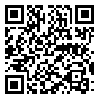Volume 23, Issue 1 (March-In press 2025)
Iranian Rehabilitation Journal 2025, 23(1): 0-0 |
Back to browse issues page
Download citation:
BibTeX | RIS | EndNote | Medlars | ProCite | Reference Manager | RefWorks
Send citation to:



BibTeX | RIS | EndNote | Medlars | ProCite | Reference Manager | RefWorks
Send citation to:
Shirshekan Z, Alizadeh A, Amerzadeh M, Mohammadi F, Motalebi S A. Predictors of Active Aging Among Community-Dwelling Older Adults in Qazvin City, Iran, 2023. Iranian Rehabilitation Journal 2025; 23 (1)
URL: http://irj.uswr.ac.ir/article-1-2256-en.html
URL: http://irj.uswr.ac.ir/article-1-2256-en.html
Zahra Shirshekan1 
 , Ahad Alizadeh2
, Ahad Alizadeh2 
 , Mohammad Amerzadeh3
, Mohammad Amerzadeh3 
 , Fatemeh Mohammadi3
, Fatemeh Mohammadi3 
 , Seyedeh Ameneh Motalebi *3
, Seyedeh Ameneh Motalebi *3 


 , Ahad Alizadeh2
, Ahad Alizadeh2 
 , Mohammad Amerzadeh3
, Mohammad Amerzadeh3 
 , Fatemeh Mohammadi3
, Fatemeh Mohammadi3 
 , Seyedeh Ameneh Motalebi *3
, Seyedeh Ameneh Motalebi *3 

1- Student Research Committee, Qazvin University of Medical Sciences, Qazvin, Iran
2- Microbiology Research Center, Qazvin University of Medical Sciences, Qazvin, Iran
3- Metabolic Diseases Research Center, Research Institute for Prevention of Non-Communicable Diseases, Qazvin University of Medical Sciences, Qazvin, Iran
2- Microbiology Research Center, Qazvin University of Medical Sciences, Qazvin, Iran
3- Metabolic Diseases Research Center, Research Institute for Prevention of Non-Communicable Diseases, Qazvin University of Medical Sciences, Qazvin, Iran
Abstract: (750 Views)
Objective: This study aims to determine the predictive factors of active aging among older people in Qazvin City, Iran.
Methods: This study, conducted in 2023, included individuals aged > 60 years in Qazvin City. Participants were selected using cluster sampling in three zones of Qazvin City. Older adults were selected from mosques and parks in each zone. Data were collected using a demographic information checklist, an Iranian active aging questionnaire, a multidimensional scale of perceived social support (MSPSS), and the World Health Organization disability assessment schedule (WHODAS 2.0). A multiple linear regression was performed using R software to detect predictors of active aging.
Results: The average age of the patients was 66.78 ± 6.22 years. A total of 178 patients (61.6%) were men and 207 (71.6%) were married. The average score for active aging was 109.18 ± 24.15, indicating a moderate level. Multiple regression analysis showed that sex, marital status, educational level, economic situation, job, perceived health, disability, and perceived social support were significant predictors of active aging.
Conclusion: Based on our results, active aging among older adults was moderate. We suggest that health policymakers pay more attention to older individuals with low literacy, low income, disabilities, and health problems when planning active aging programs. Additionally, increasing intergenerational support is vital to encourage social participation among older adults.
Methods: This study, conducted in 2023, included individuals aged > 60 years in Qazvin City. Participants were selected using cluster sampling in three zones of Qazvin City. Older adults were selected from mosques and parks in each zone. Data were collected using a demographic information checklist, an Iranian active aging questionnaire, a multidimensional scale of perceived social support (MSPSS), and the World Health Organization disability assessment schedule (WHODAS 2.0). A multiple linear regression was performed using R software to detect predictors of active aging.
Results: The average age of the patients was 66.78 ± 6.22 years. A total of 178 patients (61.6%) were men and 207 (71.6%) were married. The average score for active aging was 109.18 ± 24.15, indicating a moderate level. Multiple regression analysis showed that sex, marital status, educational level, economic situation, job, perceived health, disability, and perceived social support were significant predictors of active aging.
Conclusion: Based on our results, active aging among older adults was moderate. We suggest that health policymakers pay more attention to older individuals with low literacy, low income, disabilities, and health problems when planning active aging programs. Additionally, increasing intergenerational support is vital to encourage social participation among older adults.
Article type: Original Research Articles |
Subject:
Aging Studies
Received: 2024/05/4 | Accepted: 2024/08/26 | Published: 2025/03/27
Received: 2024/05/4 | Accepted: 2024/08/26 | Published: 2025/03/27
Send email to the article author





